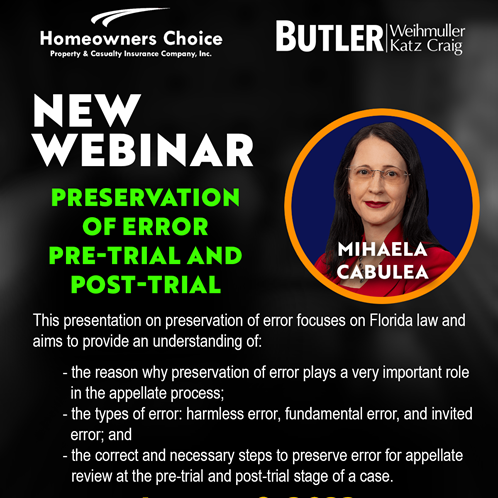
Policyholder Bears the Burden of Proving Efficient Proximate Cause and Ensuing Loss Under an All-risks Policy
Overview | Blog Posts, Court Decisions | Appellate | Related | Print | Share
September 25, 2015
Peek v. Am. Integrity Ins. Co. of Fla., No. 2D14—780, 2015 WL 5616294 (Fla. 2d DCA Sept. 25, 2015).
SIGNIFICANCE
The court held that, under the efficient proximate cause rule, a policyholder has the initial burden of proving that a covered loss was the “most substantial or responsible” cause of the loss. The court also held that, pursuant to an ensuing loss provision, a policyholder has the burden to demonstrate that the policy covered a loss that occurred subsequent to and as a result of that excluded peril.
FACTS
The policyholders made a Chinese drywall claim under an all-risk policy. The insurer denied the claim based on policy exclusions for latent defects, corrosion, pollutants, and faulty, inadequate or defective construction materials. The policyholders sued the insurer for breach of the insurance contract.
The parties litigated the case under the concurrent cause rule set forth in Wallach v. Rosenberg, 527 So. 2d 1386 (Fla. 3d DCA 1988). Under this rule, the policyholders’ burden was to prove that a covered peril at least contributed to the cause of the loss. The policyholders’ theory of the case was that Florida’s high humidity was a concurrent cause that acted in concert with the Chinese drywall to cause the loss.
At trial, the policyholders presented evidence that they had suffered a property loss within the insurance policy period. But the policyholders did not present any evidence as to the cause of their loss. The insurer presented expert testimony that the Chinese drywall: (1) was a faulty, inadequate, or defective construction material; (2) caused corrosion; and (3) was itself a pollutant. The insurer’s expert also testified that humidity was not a factor behind the policyholders’ loss. The policyholders did not present any rebuttal evidence to prove any ensuing losses or any exceptions to the policy exclusions.
Both parties then moved for directed verdict. The policyholders argued that humidity was a concurrent covered cause of the loss. The insurer argued that the defective Chinese drywall was the sole cause of the loss. The trial court reserved ruling on the motions.
The next day, the insurer presented to the trial court the newly-released opinion in Am. Home Assur. Co. v. Sebo, 141 So. 3d 195 (Fla. 2d DCA 2013), rev. granted, 160 So. 3d 898 (Fla. 2014), as support for its renewed motion for directed verdict. The Sebo opinion had rejected the concurrent cause rule from Wallach and held that the efficient proximate cause rule applied instead. Under the efficient proximate cause rule, a loss is covered only if the efficient proximate cause of the loss is a covered peril. The policyholders asked the court to decide the motions for directed verdict based on the efficient proximate cause rule from Sebo and did not ask to reopen their case or move for a mistrial. The trial court ruled that the Chinese drywall was the efficient proximate cause of the loss. The trial court then granted the insurer’s motion for directed verdict and entered final judgment for the insurer.
ISSUE
The appellate court addressed two issues: (1) whether the policyholders had presented evidence that their loss had been caused by the combination of a covered peril (humidity) and an excluded peril (Chinese drywall); and (2) whether the policyholders had presented evidence that their loss was an “ensuing loss” under the policy.
ANALYSIS
The appellate court first ruled that the policyholders had not established that humidity contributed to their loss. The appellate court explained that generally, in cases involving an “all-risks” policy, the policyholders have the burden of proving that a property loss occurred while the policy was in force. However, under the efficient proximate cause doctrine, the policyholders also have the burden of proving that a covered peril was the “most substantial or responsible” cause of the loss. The policyholders, in this case, met the general burden of showing a property loss during the policy period but did not meet the specific burden of showing that the efficient proximate cause of the loss was a covered peril. The evidence showed that the sole cause of the loss had been the Chinese drywall, an excluded peril. For this reason, the appellate court concluded there was no question for the jury to resolve.
The appellate court next ruled that the policyholders had not proven a covered “ensuing loss” under the policy. The appellate court stated that the policyholders had the burden to show that the policy covered a loss that occurred subsequent to, and as a result of, an excluded peril. The policyholders argued that the loss of use of their home due to odor and subsequent damage to metals and electronics were both covered ensuing losses. The appellate court rejected this argument because the excluded peril (Chinese drywall) had directly caused both claimed ensuing losses (odor and corrosion). The appellate court explained that “ensuing loss exceptions are not applicable if the ensuing loss was directly related to the originally excluded risks.”
Finally, the appellate court rejected—without discussion—the policyholders’ arguments that Sebo had been wrongly decided and should be reconsidered.



